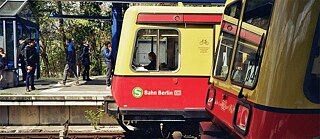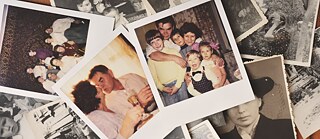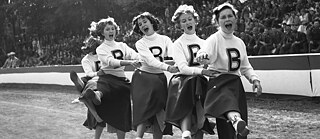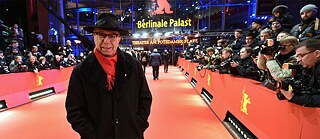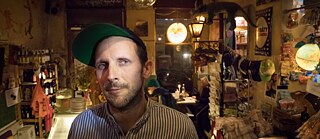Eine Stadtumrundung der besonderen Art
The Berlin Ringbahn
Die Berliner Ringbahn befördert täglich mehr als 400.000 Fahrgäste und durchquert einige der urwüchsigsten und lebendigsten Viertel der Stadt. Einen gesamten Tag lang umrundet das Produzentinnentrio die deutsche Hauptstadt und unterhält sich mit Berliner*innen, die an einer der 27 Stationen zusteigen.
Diese Folge anhören: Apple Music | Spotify | Download
Diese Folge stammt von den Berliner Radiomacherinnen Sylvia Cunningham, Monika Müller‑Kroll und Nikki Motson. Bei KCRW Berlin gestaltet das deutsch‑amerikanische Team ein englischsprachiges Programm für Zuhörer*innen aus der deutschen Hauptstadt. Für diesen Podcast steigen Monika, Sylvia und Nikki in die Ringbahn und unterhalten sich mit Fahrgästen. Bei der Musik in der Folge handelt es sich um: „Midas Tongue“ von Sam Beam und Jesca Hoop, lizensiert via Sub Pop Records; „Comptine d’un autre été“ von Yann Tiersen, gesungen von einem Straßenmusiker; „Pears“ von Jonathan Kroll, mit freundlicher Genehmigung des Musikers sowie „Berlin Ladies“ von Warner Poland und Wolfgang Glum, lizensiert via Monobeat Music Berlin. Das Foto zur Folge stammt von Ama Split und Riky Kiwy, die eine Fotosammlung zum Thema ÖPNV erstellt haben. Es zeigt die Berliner Ringbahn an der S‑Bahn‑Station Treptower Park. Außer dieser Episode haben Sylvia Cunningham und Monika Müller‑Kroll die Folgen „I Love You, I Hate You“ und „Little America Revisited“ aufgenommen, Monika produzierte mit Dina Elsayed zudem „The Diary“. Zwei dieser Podcasts stehen unter den Titeln „Das Tagebuch – The Diary“ und „Little America“ auch in deutscher Sprache zur Verfügung. Gemeinsam mit Nikki Motson produzierten Sylvia und Monika darüber hinaus die Folgen „Legacies of the Berlin Wall“ und „Luftbrücke – 70 Years of Memories“.
Transkript
[S-BAHN TRAIN DOORS CLOSING, PEOPLE CHATTING]
Ama Split: The Ringbahn is really a symbol of Berlin because it goes around the city. It goes everywhere — East, West, North, South.
Cornelius Kibelka: It’s part of living in a huge city, yeah. So you always see something funny on the S-Bahn. That’s Berlin life.
Robin Kellermann: Just look at the plots of a Netflix series, whatever, of a 1950s movie. It’s quite often when people are getting to know each other by chance, and when? When people are waiting.
Ama Split: So it’s also a story. The Ringbahn is also a story of Berlin.
Monika Müller-Kroll: The Ringbahn is a loop of train tracks around Berlin. It’s made up of city rail lines, commonly called ‘S-Bahn’ here. Hundreds of thousands of people travel on it every day.
Nikki Motson: The Ringbahn wraps around Berlin in one infinite circle without a distinct start or end, and we’re going to take you along on a ride.
Sylvia Cunningham: We’ll explore why the Ringbahn is more than just a way to get from one end of Berlin to the other. We’ll hear from a photographer, a local Ringbahn expert, and a researcher who looks at an aspect of public transport most of us probably overlook.
Nikki Motson: And we’ll talk to people who ride the Ringbahn all the time. I’m Nikki Motson.
Monika Müller-Kroll: I’m Monika Müller-Kroll.
Sylvia Cunningham: And I’m Sylvia Cunningham.
[RINGBAHN DOOR OPENING]
Sylvia Cunningham: The first stretches of the Ringbahn were built in the mid to late 1800s. These days, many people rely on the Ring to get around.
[SYLVIA CUNNINGHAM ON THE PLATFORM: “TAKE THIS DOWN, HELLO TEST TEST ONE TWO THREE TEST”]
Sylvia Cunningham: I’m about to meet a photographer who splits her time between Berlin and France.
So. Tell me who you are and where we are right now.
Ama Split: So I am Ama Split, and now we are in Sonnenallee S-Bahn Ring station in Berlin, Germany.
[NOISES FROM SONNENALLEE S-BAHN STATION PLATFORM]
Sylvia Cunningham: Ama Split got to know the Ringbahn through the lens of her analog camera, a Nikon from 1983. She and her partner Riky Kiwy are the co-authors of a photo book called “Hundekopf: The Berlin Ringbahn.”
Ama Split: ‘Hundekopf.’ It means in German, a dog’s head because when you see it on the map, when you take the metro’s map for the tourist, it’s just like a circle. But when you see it for real, it really has a dog’s head shape, like you can draw an eye and maybe a mouth, and so we said, “Yeah, that’s really nice to call it by its name, Hundekopf.” Some people call it like this.
Sylvia Cunningham: Yeah, so the ears are around Landsberger Allee.
Ama Split: And the nose is Westend, Jungfernheide. And maybe the eyes would be in Westhafen, Wedding. Yeah, now it’s really nice to me because I see it like a real dog, so I have some kind of sympathy for him, like I’m riding the dog. I don’t know. I’m a little bit crazy! [LAUGHS]
Sylvia Cunningham: There are 27 stops on the Ringbahn. And over six weeks one spring, Ama Split and Riky Kiwy photographed them all. They had rules, like only one roll of film per person per stop — that’s 36 photos each.
Ama Split: And when we decided to go, when we said, “OK, today we go.” If it was raining, we had to go. If it was very sunny, we had to go — no, “OK, let’s go tomorrow,” no, we did it. And so we stopped in each station and we said, “OK, we stay a few hours,” not a lot. And just to capture the feeling around the station, around the neighborhood — the people, what they are doing, strange things that we see or funny things.
Sylvia Cunningham: One of the stops in the western part of the city is called Halensee. It’s at the foot of Ku’Damm, one of Berlin’s most famous boulevards.
Ama Split: Yeah, you can see old people like if you were in a little town in Germany, drinking beer and yeah — you do two steps from the station of the S-Bahn, and you have these big houses with the green, with the garden, and you say, “bwoa!” It’s like being, yeah, family in the countryside, but you are in the capital of Germany.
[SIRENS WAILING]
Sylvia Cunningham: That small town feel and drinking beer — there’s one photo in “Hundekopf” in particular that shows just that. Ama recalls how she captured the moment.
Ama Split: And then I did a picture of a building and I was like, oh, there is a wall there. Let’s see what there is behind this wall, because it was near the train railway. So I said, maybe I can see the S-Bahn in another point of view, and then I was like climbing the wall with my camera, and I popped up, and I saw all these old people. Like there are four people. They are sitting in a bench with beers, and behind this wall it’s a bar, and it’s the terrace of a bar and they’re just drinking their beer. And they saw me, and they were like, “Oh! What is this? What is this little face popping up behind this wall?” And I was like, “Hello! Uh, I’m sorry,” with my bad German, and they were like, “Oh! You are French, oh!” And then, “Oh good, French, France!” And I said, “Can I take a picture?” And they were like, “Yeah, sure!” And they put the thumbs up, to say, yeah, do the picture and then I did this picture and these men, they are laughing, very happy at the sun, drinking beer.
Sylvia Cunningham: Ama Split and Riky Kiwy encountered a number of these everyday moments as they traveled clockwise on the Ring. Their photo book, “Hundekopf,” is proof of what you can capture, if you only take a little time to look around.
[BUSKER BOARDING THE RINGBAHN BEGINNING TO PLAY YANN TIERSEN’S “COMPTINE D`UN AUTRE ÉTÉ: L`APRÈS MIDI” ON THE GUITAR]
[FOOTSTEPS ON PAVEMENT]
Nikki Motson: Hello! Hi I’m Nikki. I’m with KCRW Berlin, we’re an English-language radio station, and we’re just talking about the Ringbahn. Can I just ask if you use the Ringbahn regularly?
Sarah Metzner: Yes. Every morning and every afternoon going to work. Yeah.
Nikki Motson: And you live here?
Sarah Metzner: Yes.
Nikki Motson: Do you use the Ringbahn?
Sarah Metzner [IN GERMAN]: Benutzt du die Ringbahn?
David Metzner: Yes.
Nikki Motson: How old are you?
Sarah Metzner [IN GERMAN]: Wie alt bist du?
David Metzner: Six.
Nikki Motson: Six years old? OK! And yeah, what is the significance of the Ringbahn for your daily life and as part of your neighborhood?
Sarah Metzner: That it usually causes trouble — you’re late because something’s happening. So yeah. It’s never boring — it’s frustrating — but never boring.
Monika Müller-Kroll: I agree, it’s not boring on the Ringbahn. Let’s hear from some more Berlin residents about their daily commute. Wow. So you see a lot, right?
Female voice [FROM SPAIN]: Yeah. I do see a lot.
Monika Müller-Kroll: What’s the fun stuff you see?
Female voice [FROM SPAIN]: For example, this morning I was going to work and there was this guy. He had huge muscles, with a lot of muscles, lot of tattoos. Bald. With his headphones, dancing, sitting down. And all the people, we were like, going to work, and I was like oh my God.
Sylvia Cunningham: Do you ever ride around and around?
Male voice [FROM GERMANY]: No. No, thank you.
Female voice [FROM THE UNITED STATES]: I’m from L.A., so I think anything here in Berlin like with transportation, I think, is very efficient and good.
Male voice [FROM SYRIA]: So now I’m waiting for the S-Bahn.
Monika Müller-Kroll: And you just came off work? What do you do?
Male voice [FROM SYRIA]: In hotel.
Monika Müller-Kroll: Hotel. OK. So you’re tired now, huh?
Male voice [FROM SYRIA]: Yeah.
Sylvia Cunningham: What were you listening to before we approached you? What music?
Male voice [FROM SYRIA]: Listen?
Sylvia Cunningham: Yeah, what were you listening to? What music?
Male voice [FROM SYRIA]: No I watch a program — a program in Arabic.
Sylvia Cunningham: Oh, OK. Where are you from?
Male voice [FROM SYRIA]: Damascus, Syria.
Nikki Motson: We’ll check in with some more passengers later, but first, I’m meeting up with somebody who’s a bit of an expert on Berlin’s history and public transportation. In fact, he’s been writing Wikipedia articles about it since he was 14. He’s a 29-year-old born and bred Berliner. He kind of has a thing for the Ringbahn.
[ANNOUNCEMENT IN RINGBAHN IN GERMAN: “NÄCHSTE STATION: SONNENALLEE”]
Cornelius Kibelka: I’m Cornelius Kibelka, and I’m an aficionado of urban rail transit in Berlin, and I write a lot of Wikipedia articles about it. And at the moment, we are in front of the S- und U-Bahn station Schönhauser Allee in the neighborhood of Prenzlauer Berg in Berlin.
Nikki Motson: Tell me, why you have such an interest in public transportation in Berlin.
Cornelius Kibelka: You see a lot of history in our public transport because Berlin’s history is rich, in terms of what happened. You can see two World Wars, you can see hyperinflation in the ’20s, you can see the rise of fascism in this public transport also. You can see the division of Berlin and reunification. You can see that — everything — in public transport and you see how it developed and where we still have gaps in our public transport system. That’s because of, for instance, the division of Berlin. You can see that until today, and I think that’s pretty fascinating.
Nikki Motson: When the Berlin Wall went up in 1961, it cut the Ringbahn in two. But the Ring continued to be operated by East German railways, even in the western part of the city.
Cornelius Kibelka: That’s why it became a political target for West Berlin politicians because they said, “Oh, if you’re using the S-Bahn in West Berlin, you’re supporting the East German railways and so that way, you’re supporting the East German politics, the East German politicians, and you’re supporting the Wall,” basically.
Nikki Motson: Passenger numbers fell. After years of negotiations, West Berlin won ownership of the lines in the West, but then, to everyone’s surprise, the Wall fell. The Ringbahn was eventually reconnected, but throughout these decades, various underground and overground lines were built to bypass the political battles of a city split in two. Having grown up near a Ringbahn station, Cornelius’s fascination with its history goes back to his childhood.
Cornelius Kibelka: Around the corner basically was my kindergarten, my childcare. And we always crossed the bridge there, and we always stopped here and we waved the S-Bahn driver. Because it was pretty fascinating to see all these trains passing by. And I remember until today — the drivers were always waving back. Yeah, and always smiling. I thought that was pretty unique, because I was creating a smile to someone and he was creating a smile for me. So that’s actually yeah — that’s my first childhood memory with S-Bahn.
Nikki Motson: How could they not smile?
[WALKING TO PLATFORM]
Nikki Motson: How old were you when you were able to ride the trains on your own to go visit a friend or something? Do you remember?
Cornelius Kibelka: Yeah, I did that when I was 10 or 11. My mom was pretty confident that I knew where I was going to and trusted me in a way, so that wasn’t a real problem. Yeah.
Nikki Motson: I think that’s probably a common age still today in Berlin when you look around. OK, let’s go get on the train.
[S-BAHN DOOR CLOSING]
Cornelius Kibelka: Yeah, but people are sharing a space, independent of class or hierarchy or race or color, and one needs to use it because as I said, it’s the best way to go through the city.
Nikki Motson: Yeah, one of the places where everyone comes together, regardless of which neighborhood they’re from. Everybody gets on the Ringbahn at some point.
Cornelius Kibelka: In Berlin, you always get home. There’s always a bus connection, a train connection. Sometimes it’s even quicker to get home by night than by day.
Nikki Motson: What kind of people do we see on the train right now and how would this look different, let’s say ... I don’t know, 5am Saturday morning?
Cornelius Kibelka: More drunken people, more people that are listening to music loudly, and so ... we need to get off.
[GETTING OFF TRAIN, WALKING TO THE BRIDGE]
Nikkie Motson: Outside, we pause.
Cornelius Kibelka: Yeah, here again on the bridge over the tracks, I could spend hours here, just watching the trains passing by and stopping and people leaving the train and boarding the train. I think it’s so beautiful in a way.
Nikki Motson: I don’t know how many times Cornelius Kibelka has stood and just enjoyed trains going by, but I get the feeling he’ll keep doing it for a long time to come.
[MUSIC SNIPPET FROM “ODESZA LIVE ON MBE”]
Sylvia Cunningham: Wait, is this your train?
Rija: Yeah. You can come in!
Monika Müller-Kroll: Yeah, we’ll come in.
Sylvia Cunningham: It’s Friday night, getting close to midnight. It’s a little chilly, a little windy. Monika and I are talking to people whose nights are just getting underway. We start at Westhafen station.
[GETTING ON THE TRAIN]
Monika Müller-Kroll: Just a few questions.
Sylvia Cunningham: We get on board with Malte and Rija. Rija is wearing a blue fur coat.
Rija: We have pretty much a lot of Ringbahn experience.
Monika Müller-Kroll: And how is that?
Sylvia Cunningham: Tell us more.
Rija: OK. The classic Ringbahn event is falling asleep after going out.
Malte: And going around and around.
Rija: And getting your phone stolen.
Monika Müller-Kroll: Really? So that happened to you a couple of times?
Rija: No, to me never. But to almost all of my friends actually. So it’s classic because you have it in your hand, and you drop it when you fall asleep. And someone just goes by and grabs it. Yeah, it’s a classic.
Sylvia Cunningham: Yeah. Wait, can you just describe your fabulous coat you wear? Is this a going out staple?
Rija: Yeah, totally.
Sylvia Cunningham: It’s a blue fur, like, I don’t know. How do we describe it?
Rija: We describe it as ‘besoffener Eisbär’ which is in German, the ‘drunk polar bear.’ But ‘blue’ means ‘drunk’ in German, like, “Ich bin so blau” means “I’m so drunk.”
Sylvia Cunningham: It’s the perfect look.
Monika Müller-Kroll: We get out of the train at Prenzlauer Allee, and we come across a few guys on their way home from a night playing cards.
Olli: We just meet him at the game store this evening. Now he has some questions about the Ringbahn and he will [PAUSES], it’s this one, S42. To Gesundbrunnen. And then into the U8. [LAUGHS]
Monika Müller-Kroll: It’s all documented. And you just made two German friends?
Male speaker [FROM THE NETHERLANDS]: Yeah, kind of. Well, I’ll probably never see them again. But they were very nice to me. [LAUGHS]
Monika Müller-Kroll: Have you shared a beer tonight?
Olli: No, we play cards tonight! [TRAIN ARRIVING] That’s yours, take this to Gesundbrunnen.
Male speaker [FROM THE NETHERLANDS]: Thanks, nice meeting you.
Monika Müller-Kroll: Bye!
Sylvia Cunningham: We part ways and wait for the next train. And speaking of which — Monika, you talked to someone who knows quite a bit about waiting.
Monika Müller-Kroll: Yes, I did. Robin Kellermann. He is a PhD student, research assistant, and lecturer at TU, the Technische Universität Berlin. He’s interested in the cultural history of waiting, especially as it relates to mobility and public transportation. Robin lives close to the Ringbahn stop Schöneberg, so that’s where I meet him.
[MONIKA AND ROBIN CHATTING ON THE PLATFORM AS AN S-BAHN TRAIN LEAVES THE STATION]
Monika Müller-Kroll: This is really unique, no? I mean nothing sounds like the Ringbahn in Berlin.
Robin Kellermann: I think Seoul, or Tokyo, or even Leipzig and Milwaukee, that each city has more or less its own soundscape, when it comes to indicating if a train is arriving or closing its doors.
Monika Müller-Kroll: So which direction do you want to go? Clockwise?
Robin Kellermann: I say, we should go anti-clockwise.
Monika Müller-Kroll: OK. While we are waiting, we should talk about waiting, because that’s one of the topics you’re really interested in. You say, waiting is the stepchild of mobility.
Robin Kellermann: Yes, I think it is. Because there’s one problem in the history of modernity because the history of modernity, in my opinion, has been narrated most prominently — for good reasons — with the terms of acceleration, of progress. But actually, on the backside of these processes, there’s something which is very mundane and very simplistic, that millions of people and passengers had to wait for something like this. [TRAIN APPROACHING THE PLATFORM] For public transportation. And this has formed a cultural practice, but a practice which is very necessary to enter a train, but it has been neglected and ignored and overlooked in research and also when it comes to transport planners. So, it’s kind of a stepchild. It has to be detested, it has to be avoided by any means, but when we look at the actual in-transit practice, it’s one of the most fundamental parts of our journey, and so there is a mismatch between the phenomenon and actually the perception of waiting.
[RINGBAHN DOOR CLOSING]
Robin Kellermann: I mean, we are waiting all the time. It’s nothing completely new, but the way we are waiting in transport has created a new cultural practice, I would say. My job is especially to shed light on the historical evolution of this temporal phenomena.
Monika Müller-Kroll: And what was it like, let’s say in the ‘20s, waiting here at the platform at the Berlin Ringbahn?
Robin Kellermann: Yeah, good question. I would say it has already been quite stressful. Mainly working class were using this Ringbahn, especially in the 1920s. And I think the regime of machines and the time regime was very much internalized already, and so time had become something critical, like I don’t know 100 years earlier, time had not become so scarce. [DOOR CLOSING]
Monika Müller-Kroll: It’s quiet here because we missed the rush hour. What do you think about the noise level? Were people louder then maybe? Or maybe not. Maybe they were quieter.
Robin Kellermann: They were louder, definitely. The Ringbahn had some two classes, second and third class. There was no first class in the beginning. I mean now — since long, long, long time — we have got rid of any class separation in public transportation at least in Germany. And it was much louder, because it was much more crowded. People were smoking, people were drinking, people were, I mean they are doing it still. [LAUGHS]
Monika Müller-Kroll: Yeah, I was gonna say. Nothing has changed.
[TRAIN PASSING BY]
Monika Müller-Kroll: When we look around, you barely see someone reading a newspaper. How has technology, or the digital revolution changed our waiting pattern?
Robin Kellermann: Drastically. Still, waiting previously in the long history of 150 years since the first railways, has always been filled with uncertainty. And this for the first time with new technologies, with our smart phone, has been diminished. Maybe it has been removed completely because we are aware of what’s going on. You see these real-time information systems that are indicating when a train is coming, and psychologically, if this would not be there, it makes a huge difference. A huge difference. Psychology has revealed how much we are overcharging our own estimation of time, with and without those systems. And so the question is, I mean, we are very productive all the time. Are we waiting any longer? Or do we really wait in the purest sense? I would say, I mean, that’s an open question.
[GUITAR PLAYING]
Monika Müller-Kroll: I’m at the Ringbahn station Hermannstrasse, and I come across these four ladies. They are talking and laughing. I approach them by asking where they’re from.
[MUSIC BEGINS “EVENINGS NEAR MOSCOW”]
Monika Müller-Kroll [IN GERMAN]: Sie kommen nicht aus Berlin?
Renate [IN GERMAN]: Doch! Wir steigen öfters mal irgendwo ein und fahren durch ganz Berlin. Ist egal, ob mit der Ringbahn oder ... [CONTINUES TALKING INDISTINCTLY]
Monika Müller-Kroll: They are real Berliners. They say, they like to get on any train, they do that quite often, without a real destination and ride through Berlin. [IN GERMAN] Kaffee oder?
Renate [IN GERMAN]: Ja, Kaffee trinken ... [CONTINUES TALKING INDISTINCTLY]
Monika Müller-Kroll: They are all retired. Today they are heading to the Estrel Hotel to have some coffee.
Renate [IN GERMAN]: Wir sind eine Familie. Drei Schwestern und Cousine.
Monika Müller-Kroll: I ask them about their relationship ...
Renate [IN GERMAN]: Wir machen immer alles zusammen.
Monika Müller-Kroll: And it turns out, they are three sisters and a cousin. [IN GERMAN] Sie sind viel unterwegs! They do a lot of stuff together, but they live all over Berlin. [IN GERMAN] Wo wohnen Sie in Berlin?
Renate [IN GERMAN]: Jede woanders, haben wir gerade festgestellt. Wilmersdorf, Wedding, Reinickendorf ... [CONTINUES TALKING INDISTINCTLY]
Monika Müller-Kroll: They tell me that they keep an eye on their neighborhoods. They control the city.
Renate [IN GERMAN]: Jeder beobachtet seinen Bezirk.
Monika Müller-Kroll: And then the Ringbahn arrives, and they leave, talking and laughing.
Renate [IN GERMAN]: Alles Gute für Sie!
Monika Müller-Kroll [IN GERMAN]: Ihre Vornamen?
[ONE AT A TIME, THEY ANSWER, “RENATE! BRIGITTE! CAROLA! KARIN!”]
Monika Müller-Kroll [IN GERMAN]: Vielen Dank. Tschüss, ladies!
[MUSIC ENDS “EVENINGS NEAR MOSCOW”]
Monika Müller-Kroll: Thanks for coming along with us on our ride on the Ringbahn.
Nikki Motson: Special thanks to Ama Split, Cornelius Kibelka, and Robin Kellermann for sharing their insights.
Sylvia Cunningham: And to all the travelers we met along the way. In Berlin for THE BIG POND, I’m Sylvia Cunningham.
Nikki Motson: I’m Nikki Motson.
Monika Müller-Kroll: And I’m Monika Müller-Kroll.



